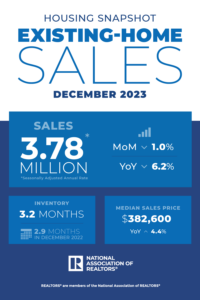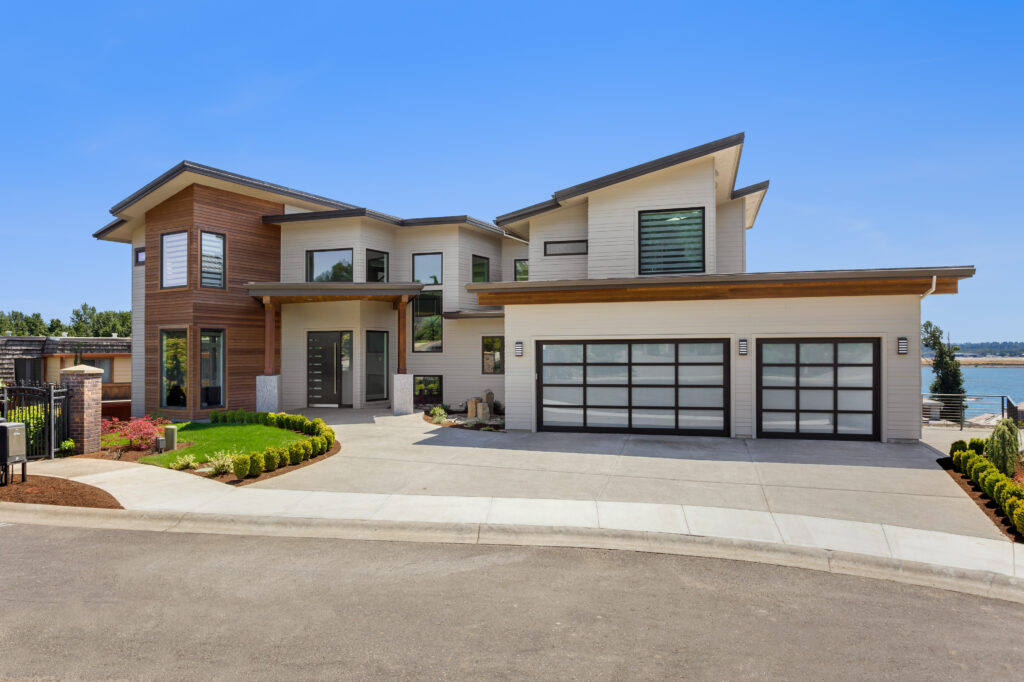
According to the National Association of Realtors (NAR) existing-home sales retreated in December 2023 dropping to an annual level of 4.09 million units—the lowest level reported since 1995—as the median sales price reached a record high of $389,800 by the end of the calendar year.
Total existing-home sales—completed transactions that include single-family homes, townhomes, condominiums and co-ops—decreased 1.0% from November to a seasonally adjusted annual rate of 3.78 million in December. Year-over-year, sales declined 6.2% (down from 4.03 million in December 2022).
“The latest month’s sales look to be the bottom before inevitably turning higher in the new year,” said NAR Chief Economist Lawrence Yun. “Mortgage rates are meaningfully lower compared to just two months ago, and more inventory is expected to appear on the market in upcoming months.”
Total inventory at the end of December was about 1 million units, a number which is down 11.5% from November 2023 but up 4.2% year-over-year. Unsold inventory sits at a 3.2-month supply at the current sales pace, down from 3.5 months in November but up from 2.9 months in December 2022.
Existing median home sales prices for all housing types in December was $382,600, an increase of 4.4% from December 2022 when it stood at $366,500.
Looking at the four major regions of the U.S., sales slipped in the Midwest and South, rose in the West and were unchanged in the Northeast. All four regions experienced year-over-year sales decreases.
At 470,000 units, existing-home sales in the Northeast were unchanged from November but down 9.6% from December 2022. The median price in the Northeast was $428,100, up 9.4% from the previous year.
In the Midwest, existing-home sales retracted 4.3% from the prior month to an annual rate of 900,000 in December, down 10.9% from last year. The median price in the Midwest was $275,600, up 5.9% from December 2022.
Existing-home sales in the South descended 2.8% from November to an annual rate of 1.72 million in December, a decrease of 4.4% from the prior year. The median price in the South was $352,100, up 3.8% from one year ago.
In the West, existing-home sales grew 7.8% from a month ago to an annual rate of 690,000 in December but were down 1.4% from one year before. The median price in the West was $582,000, up 4.8% from December 2022.
“Despite sluggish home sales, 85 million homeowning households enjoyed further gains in housing wealth,” Yun added. “Obviously, the recent, rapid three-year rise in home prices is unsustainable. If price increases continue at the current pace, the country could accelerate into haves and have-nots. Creating a path towards homeownership for today’s renters is essential. It requires economic and income growth and, most importantly, a steady buildup of home construction.”
In other data:
- Properties typically remained on the market for 29 days in December, up from 25 days in November.
- First-time buyers were responsible for 29% of sales in December, down from 31% the month prior.
- All-cash sales accounted for 29% of transactions in December, up from 27% in November 2023 and 28% in December 2022.
- Individual investors or second-home buyers, who make up many cash sales, purchased 16% of homes in December, down from 18% in November and identical to one year ago.
- Distressed sales—foreclosures and short sales—represented 2% of sales in December, virtually unchanged from last month and the previous year.
- Single-family home sales edged lower to a seasonally adjusted annual rate of 3.4 million in December, down 0.3% from 3.41 million in November and 6.1% from the previous year. The median existing single-family home price was $387,000 in December, up 4.0% from December 2022.
- Existing condominium and co-op sales recorded a seasonally adjusted annual rate of 380,000 units in December, down 7.3% from November and one year ago (both 410,000 units). The median existing condo price was $343,800 in December, up 8.2% from the previous year ($317,700).
“Existing home sales slipped in December. Sales fell 1% from November to a pace of 3.78 million, which trailed the year-ago pace by 6.2%,” said Danielle Hale, Chief Economist for Realtor.com “Mortgage rates tumbled from late October through the end of the calendar year and likely kept sales from slipping further. Even though pending home sales, which mark an earlier stage in the transaction process and tend to lead existing home sales by a month or two, steadied in November, high costs stemming from high prices and mortgage rates continue to remain a challenge for many shoppers. For the year as a whole, existing-home sales totaled 4.09 million, slightly above our late-year projection.”
“Amid a slower sales pace, the median sales price rose 4.4% over the year in December even though inventory, the number of unsold homes on the market, picked up 4.2% from one year ago,” Hale continued. “Relative to the sales pace, there was just 3.2 months supply on the market, the lowest months supply in 6 months. Price gains were seen in all four regions with the strongest growth in the Northeast.
“Regionally, mortgage rate sensitivity likely played a role in sales trends. The higher cost West saw home sales growth while sales in the Northeast were flat in December. Sales in the Midwest and South eased slightly. While all four regions trail year-ago levels, the West is closest to closing the sales gap, with home sales just 1.4% below the prior year pace.”
“A recent Realtor.com study found that as the housing market slowed in 2023, investors also pulled back as costs soared and rents softened. With rents continuing to ease and more multi-family homes entering the market for rent, investors may continue to tread more cautiously in the housing market. This would mean one less source of competition for potential first-time home buyers who are approaching the 2024 market with optimism despite the challenge of trying to buy a home at a below-median price point, one that investors also often target.”
“Mortgage rates will continue to remain a wild card for home shoppers,” Hale concluded. “Although mortgage rates dropped further this week, stronger readings on inflation, which came in higher than expected in December, surprisingly strong retail sales data, and lower than expected jobless claims figures have already pushed up 10-year yields and could cause a similar reaction in mortgage rates.”
Click here to view the source report in its entirety.






